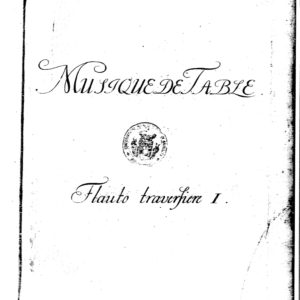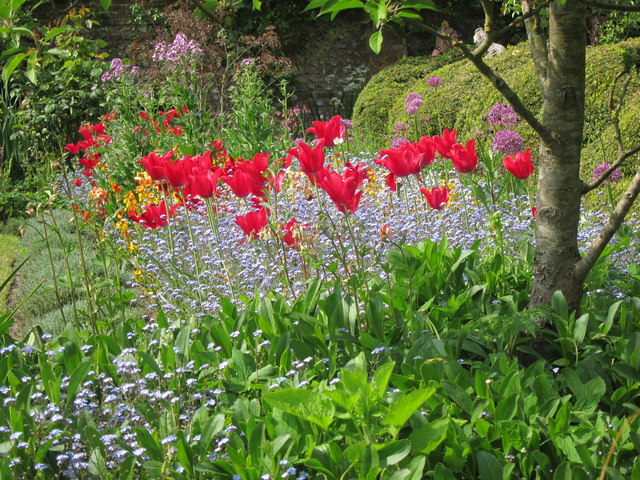
It’s a sweet story. Two men—famous composers—keep their long-distance friendship alive for a half-century sharing mutual regard and …flowers.
Georg Philipp Telemann and Georg Frederick Handel were German teenagers when they met. Life separated them thereafter, Handel becoming the titan of London’s concert scene while Telemann was Hamburg’s all-round musical dynamo. But letters and sheet music kept them in touch, despite the vagaries of 18th-century mail services.
Letters, sheet music, and flowers. When Telemann became an avid gardener in his sixties, Handel was one of the correspondents whose gifts of rare bulbs and tubers delighted him (“I am insatiable where hyacinths and tulips are concerned, greedy for ranunculi, and especially for anemones,” he wrote). True, Handel may have enjoyed sending show-off presents, “the best plants to be found anywhere in England.” But he showed real solicitude for his faraway old friend. Once he got a fright because when a shipment went missing, it was rumored that Telemann had passed away; when the rumor proved false, he rushed off a replacement crate with a note that “you can imagine my joy to find you are back in perfect health.”

See? Sweet.
We’re interested, of course, because it’s fun to hear about idols in their leisure time. But the anecdote also sheds light on the relationship and mutual respect in a broader perspective. Handel and Telemann appreciated each other’s music as well as their friendship. Telemann showed it by, for instance, producing Handel’s operas in Hamburg. And Handel showed his appreciation for Telemann’s music by borrowing or, some might say, stealing it.
Borrowing—or stealing—is one of the most vexed concepts in modern-day appreciation of 18th-century music. It was endemic in the baroque era, though. Almost all baroque composers borrowed in some form, including Telemann. They borrowed from themselves, reusing tunes or passages or even entire movements from earlier pieces and reworking them into something new. And they borrowed from their colleagues—not necessarily with acknowledgement or consent. Handel was one of the biggest practitioners (or malefactors, depending on how you look at it) of both.

Handel’s work is full of recycled passages, both his own and others’. He got called on it too, by critics over the years but also by people in his own time. “I dare say I shall catch him stealing from them…,” his friend and librettist Charles Jennens (Messiah) wrote to an acquaintance when some new Italian opera scores arrived in 1743.
Handel helped himself liberally from at least three of Telemann’s published editions (Sonates sans basse for two flutes or violins, the Harmonischer Gottes-dienst, and Musique de Table.) The thing is, Telemann knew about Handel’s appropriations but, according to a contemporary account, wasn’t bothered. It wasn’t that he was unconcerned; like others in his 18th-century circles, Telemann was in fact increasingly concerned about composer’s rights and a pioneer in intellectual property control through self-publishing. But having your work borrowed by Handel was different from having it stolen by some talentless jerk, the story goes; it was an honor and a pleasure to see what he’d do with it.

Fine lines, but unlike music historians of the 19th and 20th centuries, who chided baroque masters for their sticky fingers and derided them for failing to meet Romantic-era ideals of soul-searching introversion, our own generation of baroque music specialists takes 18th-century borrowing on its own terms. Learning more reveals a great deal about what, how and why individual artists did what they did. Consider the meaningful distinctions to be drawn between a composer like Handel, for whom sampling and reworking seemed to be essential creative tools and one like Telemann, who was more likely to draw on his own quicksilver musical imagination than rummage around on his bookshelves for inspiration.
With understanding and insights like these, the great garden of baroque music comes into tighter focus. As more is learned and translated into performance, baroque music is becoming more distinct, variegated, multifaceted, bright, and—like Telemann’s hyacinths and tulips—delightful.
Foot matter:

For further reading on 18th-century music and borrowing:
Chapter Four, “Bach’s Debt Repaid with Interest: A Case Study of Transformative Imitation,” in the indispensable Music for a Mixed Taste: Style, Genre, and Meaning in Telemann’s Instrumental Works by Steven Zohn (Oxford, 2008) gives an overview as well as the case study. Two fascinating essays are “The Case of Handel’s Borrowings: the Judgement of Three Centuries” by George J. Buelow and “Why did Handel Borrow?” by John H. Roberts, both in Handel: Tercentenary Collection ed. by Stanley Sadie and Anthony Hicks (Palgrave Macmillan, 1987).
Telemann “I am insatiable…,” letter to Uffenbach, August 1742 , Georg Philipp Telemann Briefwechsel, ed. Gross and Jung, Leipzig 1972, p. 238, original German; Handel, “The best plants…,” letter to Telemann, December 1750, original French, Briefwechsel, p. 344; Jennens, “I dare say…,”letter to Holdsworth, January 1743, Handel Reference Database, Stanford University.
______________________________
Anne Schuster Hunter is a writer and art historian living in Philadelphia. She offers a creative writing workshop
at Temple University Center City. www.anneschusterhunter.com.
